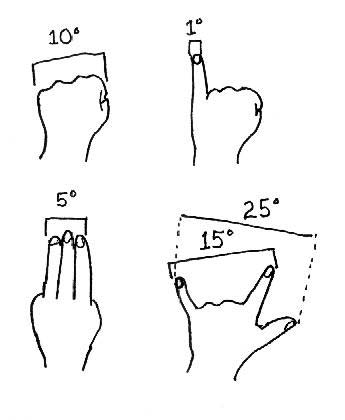First, you need to understand what you see when you look at the night sky. Forget anything you know about the shape of the earth or the universe. Those things are not as important as what you actually see. Stand in a flat, open area (or imagine yourself standing there) and look around.
You seem to be standing on a flat surface that extends out equally in all directions - a big, flat circle. The sky meets the earth circle and forms a dome overhead. The stars appear to be on the surface of the sky dome. Even the Moon appears to on the same surface as the most distant stars.
In other words, the sky seems to be shaped like a sphere.
Circular and spherical objects are commonly measured in degrees - 360 degrees in a circle. These same measurements can be applied to the sky. If the horizon is 0 degrees, then overhead is 90 degrees. That still covers a lot of space, though, and you need to measure smaller distances. Fortunately, you can, and you have the necessary equipment with you at all times.
Fully extend your arm and make a fist. The width of your fist measures approximately 10 degrees in the sky. Don't believe it? Point your fist in front of you, thumb side up, little finger side on the horizon. Stack your other fist on top of it. Keep alternating arms until you have measured nine fist widths. Where is you hand? Overhead, after counting off 90 degrees.

You can use your hand and fingers to estimate smaller and larger distances, too. Again, with you arm fully extended:
-width of pinky finger = 1 degree
-width of first three fingers (Boy Scout salute) = 5 degrees
-width of fist = 10 degrees
-distance between index and pinky fingers (Hook 'em, Horns) = 15 degrees
-distance between thumb and pinky finger (Hawaii hand) = 25 degrees
The last measurement, 25 degrees, varies somewhat because people have different hand flexibility. To see how accurate it is for you, compare it to the Big Dipper. The distance from the end of the handle to the pointer stars is also 25 degrees.
Last week, you learned how to use the Big Dipper to point to the North Star. Try finding Polaris again, this time using your hand to measure. The distance between the two pointer stars is about 5 degrees. Polaris is approximately 28 degrees away from the nearest pointer star.
Once you have found Polaris, estimate how far it is above the horizon. You'll find that this distance matches the degrees of north latitude of your viewing location. Someone in the Florida Keys would see Polaris just 25 degrees above the horizon. At the Montana-Alberta border, the North Star would be almost twice as high in the sky.
This week, take two more measurements. First, imagine the huge, orange, full moon rising over the tree tops. How many degrees wide do you think it is? Then imagine the moon is high in the sky. Does the moon seem as large as it did earlier? How many degrees wide do you think it is now?
There is a full moon this week on Wednesday, April 16, so take your predictions and your hand outside at dusk and measure the moon. Measure it again a few hours later.
Surprise! Both times, the moon measures about half a degree wide (another useful measurement to know.) The large, orange rising moon is an optical illusion. It is no larger near the horizon than it is high overhead. And even though it appear far larger than any other single object in the night sky, it still only covers a small portion of the sky.

The Piker Press moderates all comments.
Click here for the commenting policy.